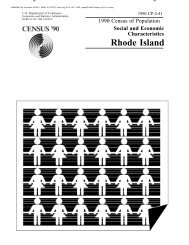Untitled - Rhode Island Historical Society
Untitled - Rhode Island Historical Society
Untitled - Rhode Island Historical Society
You also want an ePaper? Increase the reach of your titles
YUMPU automatically turns print PDFs into web optimized ePapers that Google loves.
G'<br />
=.=<br />
.=<br />
€<br />
4<br />
=j<br />
a<br />
,=<br />
=<br />
Portrait of the Chace family, 1882. Standing<br />
(left to right) are Mary Chace Tolman; her<br />
husband, James; Arnold Chace; and Lillie<br />
Chace Wyman. Seated in front of them are<br />
Elizabeth Buffutn Cbace; Eliza Greene Chace<br />
(Arnold's wife); and John Wyman. Courtesy of<br />
Sarah Rouland Sonntag and Elizabeth Steuens.<br />
116 "\7AS SHE CLOTHED VITH THE RENTS PAID FOR THESE WRETCHI,D ROOMS?''<br />
If the aging chace needed a younger comrade to take up the standard for the<br />
cause of factory women, she did not have to search very fat. Elizabeth Buffum<br />
chace's seventh child and oldest living daughter, named for her mother and<br />
nicknamed Lillie, had been baptized into a life of activism almost from the<br />
moment of her birth in December 1847.whiIe her father, Samuel chace, and<br />
his brother Harvey labored to resuscitare the struggling valley Falls company<br />
textile mill, Elizabeth Buffum Chace devoted herself to antislavery activism and<br />
motherhood. By 1843 chace's first five children, born between 1g30 and,1g4r,<br />
had all died of childhood illnesses. chace shared her cukure,s reverence for<br />
motherhood, and the excruciating deaths of her children made her almost<br />
obsessively concerned with her five children who survived: samuel, born in<br />
1843; Arnold, in 1845; Lillie, in 1847;Edward, in 1849; and the youngesr,<br />
MarS born in 1852, when Chace was forty-six years old.r.<br />
Like many female reformers of her generation who were also mothers, chace<br />
saw no conflict between her role as a parent and her vocation as a social<br />
activist. She deemed it absolutely vital to raise her children to be active in social<br />
movements, and thus Lillie and her siblings were all brought up ro be ,,good<br />
little abolitionists." During Lillie's childhood in the 1850s the chace family's<br />
homes in vailey Falls were way stations for escaped slaves and itinerant abolitionist<br />
speakers, including william Lloyd Garrison (whom the chaces revered<br />
as a sort of household saint), r7endell Phillips, Abby Kelley Fosrer, and Lucy<br />
Stone. The commodious Homestead, built by the chaces in 1g5g on Broad<br />
Street in what is now Central Falls, provided a pleasant and attractive base for<br />
chace's mingling of abolitionism and parental responsibility. As a child, Lillie<br />
read abolitionist newspapers like Garrison's The Liberator, and family legend<br />
had it that she had masrered Harriet Beecher srowe's [Jncle Tom's cabin by the<br />
time she was six years old. Together with her sister and brothers, I-illie was<br />
brought to antislavery conventions in providence and lectures in valley Falls.<br />
The children performed antislavery tableaux at local recitais, circulated petitions<br />
against slaverS and played with the children of other abolitionists.r' euaker<br />
Samuel chace, who had restored the valley Falls mills to prosperity, regarded<br />
his family's social activism with benevolent approval.3s<br />
Struggling to reconcile her activist upbringing with a love of literature, Lillie<br />
decided early on a career as an writer." During the ten years after the civil var,<br />
she published a handful of articles in reform newspapers like the Antislauery<br />
Standard and the woman's lowrnal.oo while wrestling with her vocational<br />
choice, she nominally functioned as her mother's reform helper, attending meetings<br />
and serving on committees of the <strong>Rhode</strong> <strong>Island</strong> \foman Suffrage Association<br />
and assisting at temperance activities in valley Falls.al Beset by a tendency<br />
toward mental depression in her struggle to find her own useful work, she also<br />
suffered a series of painful losses during this time: the death of her older brother<br />
Samuel in 1867 , her father's painful demise from cancer in 1 8 70, and her<br />
younger brother Ned's sudden death in 1,871.a'zThe end of the antislavery<br />
movement after the civil \war was another death that grieved her. Abolitionist<br />
children like her were "trained for a conflict in which they were not permitted<br />
to fight," she wrote, "and like the last knight of the Round rable, when that<br />
circie was dissolved 'which was an image of the mighty world,' they go forth<br />
'companionless' to meet 'new men, strange faces, other minds.,,'a3<br />
unlike her mother, Lillie had no experience of an idyllic "classless" preindustrial<br />
society. The valley Falls into which she had been born in 1847 was well on its











